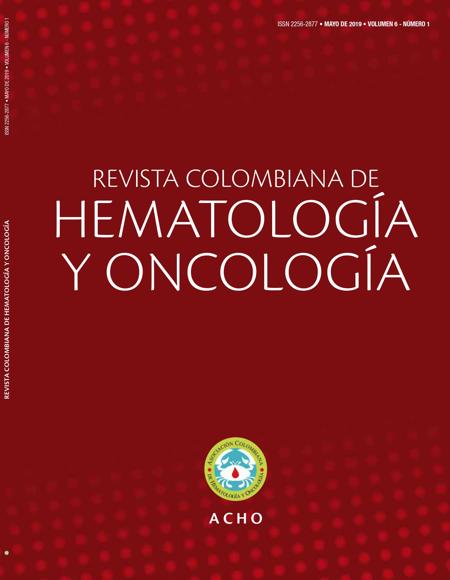Survival of breast cancer treated with neoadjuvant chemotherapy.
Supervivencia de cáncer de mama tratado con quimioterapia neoadyuvante.

How to Cite
Download Citation

This work is licensed under a Creative Commons Attribution-NonCommercial-ShareAlike 4.0 International License.
Show authors biography
Objective: To evaluate overall survival and diseases - free survival in female breast cancer patients that received neoadjuvant chemotherapy treatment. Methods: The data analysed in this study was collected between January 1st 2005 to December 31st 2014. All patients 18 and older diagnosed with breast cancer and receiving neoajuvant chemotherapy treatment were included in this study. Survival curves were created using Kaplan-Meier methods, compared using logarithmic range method and a regression analysis of proportional ranges by Cox was performed. Results: A total of 350 patients were identified in this study with an average age of 54.8 years. The most frequent clinical stages were IIB 125 (35.71%), IIIA 96 (27.43%) and IIIC 58 (16.57%). Positive estrogenic receptors were 67.14%, 54.29% for progesterone positive receptors and 15.43% for HER2 positive receptor. During the study they were 81 (23.14%) relapses and 70 (20%) deaths. Diseases free survival time decreases in massive ganglionar compromise (10 o more nodes) HR 2.96 (IC95% 1.24-3.27) and increases in patients that achieve complete pathological responses HR 0.29 (IC 95% 0.11-0.72). Global survival time decreases if they are 10 or more positive nodes HR 2.93 (IC95% 1.29-6.66) and it increases in patients that achieved complete patological responses to neoadyuvant chemoterapy treatment HR 0.43 (IC95% 0.21-0.87). Conclusion: Relapse and death risk increases with massive ganglionar compromise (10 or more positive nodes) and decreases in patients to achieve complete pathological responses to the neoadyuvant chemotherapy treatment.
Article visits 299 | PDF visits 685
Downloads
- International Agency for Research on Cancer. Globocan 2018 [internet]. [citado 2018 sep 12]. Disponible en: http://globocan.iarc.fr/
- Von Minckwitz G, Untch M, Blohmer JU, Costa SD, Eidtmann H, Fasching PA, et al. Definition and impact of pathologic complete response on prognosis after neoadjuvant chemotherapy in various intrinsic breast cancer subtypes. J Clin Oncol. 2012;30(15):1796-804.
- Mieog JS, Van der Hage JA, Van de Velde CJ. Preoperative chemotherapy for women with operable breast cancer. Cochrane Database Syst Rev. 2007;(2):CD005002.
- Chen AM, Meric-Bernstam F, Hunt KK, Thames HD, Oswald MJ, Outlaw ED, et al. Breast conservation after neoadjuvant chemotherapy: the MD Anderson cancer center experience. J Clin Oncol. 2004;22(12):2303-12.
- Kong X, Moran MS, Zhang N, Haffty B, Yang Q. Meta-analysis confirms achieving pathological complete response after neoadjuvant chemotherapy predicts favourable prognosis for breast cancer patients. Eur J Cancer. 2011;47(14):2084-90.
- Cortazar P, Zhang L, Untch M, et al. Meta-analysis results from the Collaborative Trials in Neoadjuvant Breast Cancer (CTNeoBC). Cancer Res. 2012;72:93s.
- Mathieu MC, Mazouni C, Kesty NC, Zhang Y, Scott V, Passeron J, et al. Breast Cancer Index predicts pathological complete response and eligibility for breast conserving surgery in breast cancer patients treated with neoadjuvant chemotherapy. Ann Oncol. 2012;23(8):2046-52.
- Nahleh Z, Sivasubramaniam D, Dhaliwal S, Sundarajan V, Komrokji R. Residual cancer burden in locally advanced breast cancer: a superior tool. Curr Oncol. 2008;15(6):271-8.
- Symmans WF, Peintinger F, Hatzis C, Rajan R, Kuerer H, Valero V, et al. Measurement of residual breast cancer burden to predict survival after neoadjuvant chemotherapy. J Clin Oncol. 2007;25(28):4414-22.
- Therasse P, Arbuck SG, Eisenhauer EA, Wanders J, Kaplan RS, Rubinstein L, et al. New guidelines to evaluate the response to treatment in solid tumors. J Natl Cancer Inst. 2000;92(3):205-16.
- Aranda FI, Peiró G, Niveiro M, Seguí J. Neoadyuvancia en cáncer de mama: papel del patólogo. Rev Esp Patol. 2010;43:90-3.
- Robledo JF, Caicedo JJ, DeAntonio R. Análisis de sobrevida en una cohorte de 1.328 pacientes con carcinoma de seno. Rev Colomb Cirugía. 2005;20(1):4-20.
- Sant M, Allemani C, Berrino F, Coleman MP, Aareleid T, Chaplain G, et al. Breast carcinoma survival in Europe and the United States. Cancer. 2004;100(4):715-22.
- Giltnane JM, Moeder CB, Camp RL, Rimm DL. Quantitative multiplexed analysis of ErbB family coexpression for primary breast cancer prognosis in a large retrospective cohort. Cancer. 2009;115(11):2400-9.
- Guerra MR, Mendonca GA, Bustamante-Teixeira MT, Cintra JR, Carvalho LM, Magalhaes LM. [Five-year survival and prognostic factors in a cohort of breast cancer patients treated in Juiz de Fora, Minas Gerais State, Brazil]. Cad Saude Publica. 2009;25(11):2455-66.
- Mauriac L, Keshaviah A, Debled M, Mouridsen H, Forbes JF, Thürlimann B, et al. Predictors of early relapse in postmenopausal women with hormone receptor-positive breast cancer in the BIG 1-98 trial. Ann Oncol. 2007;18(5):859-67.
- Kim J, Lee J, Chang E, Suh K, Lee C, Jee J, et al. Prognostic factors in patients with stage II/III breast cancer treated with adjuvant extension of neoadjuvant chemotherapy: a retrospective cohort study with ten-years of follow-up data. J Breast Cancer. 2011;14(1):39-45.
- Dunnwald LK, Rossing MA, Li CI. Hormone receptor status, tumor characteristics, and prognosis: a prospective cohort of breast cancer patients. Breast Cancer Res. 2007;9(1):R6.
- Grann VR, Troxel AB, Zojwalla NJ, Jacobson JS, Hershman D, Neugut AI. Hormone receptor status and survival in a population-based cohort of patients with breast carcinoma. Cancer. 2005;103(11):2241-51.

















